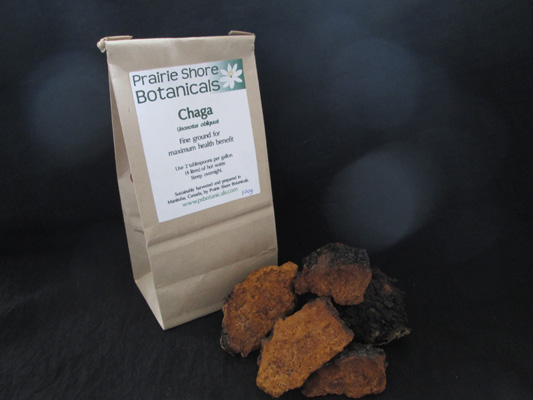Update: Prairie Shore Botanicals is no longer offering chaga because of concerns that it is being over-harvested and improperly used.
Chaga is a white rot fungus that infects birch trees. It has a long history of being used to strengthen the immune system, eliminate toxins from the body and to treat various digestive disorders. It is anti-microbial, anti-viral and anti-inflammatory. Chaga is well known for its anti-tumor properties, as well as its ability to regulate blood sugar levels. It produces no side effects, even when used on a regular, long term basis. It has a long history of use in Russia and has been certified and approved by the Russian Medical Research Council. Chaga is currently being used to treat HIV and stage 4 cancers.
Extensive research has shown that the effectiveness of chaga is due to numerous active compounds:
Betulin and betulinic acid – induces programmed cell death in tumors with no harm to normal cells.
Melanin – antioxidant; protects cell components against free radicals. The antioxidant level of chaga is at least 10 times higher than all other medicinal mushrooms.
Phytosterols (inotodiol and lanosterol) – anti-viral; effective against influenza, HIV and some cancers.
Polysaccharides, beta-D-glucans – modulate the immune system (and inhibit mutagenic and immune-modulating effects of cancerous tumors), regulate cholesterol levels, and boost brain, liver and digestive functions.
Triterpenes – can lower cholesterol and treat asthma, cough, chronic bronchitis and hepatitis
Germanium – prevents tumors, normalizes blood pressure and cleanses the blood.
Chaga does not look like a stereotypical mushroom. It appears more like a black “explosion” on the trunks of live birch trees, often taking years to attain a size suitable for harvest. Though not rare, it is not particularly common, occurring on only one in maybe 400-800 trees. Once it is removed from a tree, chaga may continue to grow, but it can take several years before it reaches a decent size again.
Chaga has three major components – an outer black crust, a brown, corky inside, and white mycelium (fungal “roots”). Each part contains different concentrations of the mostly water soluble compounds. (The outer black crust, for example, has the highest concentration of melanin.) Tea made from ground chaga provides the best combination of these compounds. Note: Do not grind chaga in a regular kitchen blender! The black crust is very hard and can do severe damage to the machine.
Chaga is also known as the “tinder fungus”. The dry, corky inside of the fungus can catch a spark and carry an ember as well as char cloth, which makes it a very valuable resource for starting fires.
For more information on chaga’s medicinal properties and how it works, check out 340 research papers.
Also check out the many websites dedicated to chaga, including www.chagamushroomguide.com

